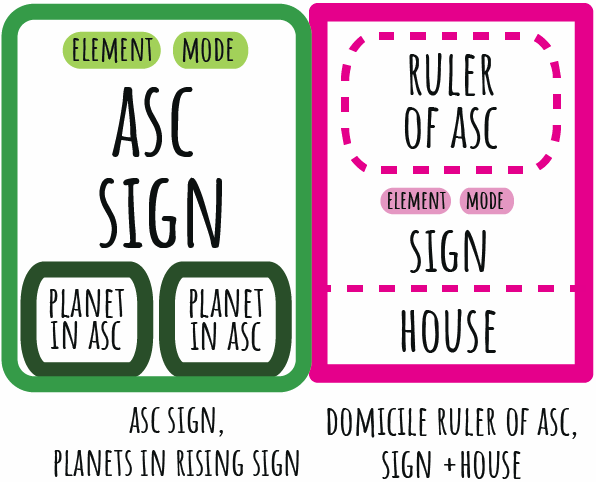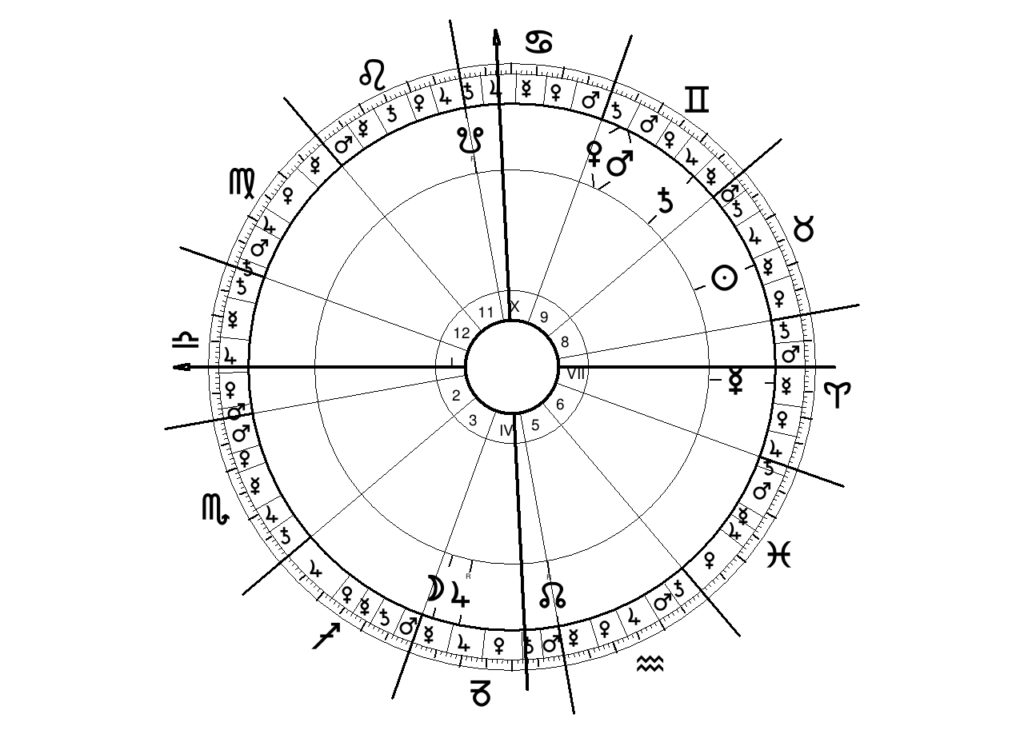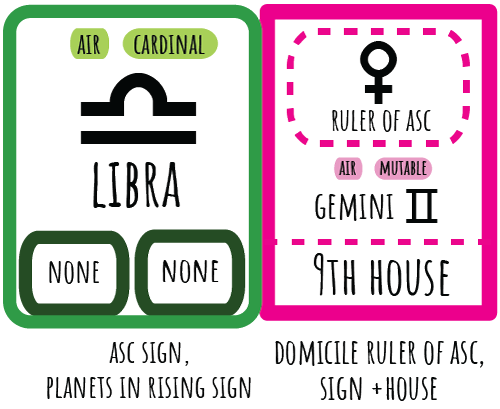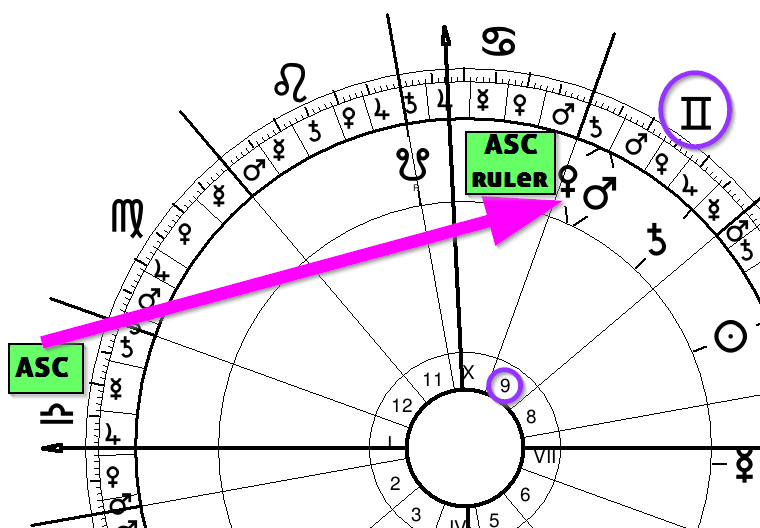intro to rubrics
To celebrate the upcoming release of my first paid astrological item and Patreon account, the Ascendant Natal Delineation Rubric printable mini-poster bundle and accompanying worksheet, I thought I’d share a bit on how I’m currently using rubrics in astrological study, and why they’re beneficial.
contents
- What’s a Rubric and Why Should I Use It?
- Background and Ideation
- The Delineation Gap, or, the Long Road to Synthesis
- Forms of Rubrics and Outlines
- How to Use a Delineation Rubric
- Practice, Practice, Practice!
- A Starting Point: the ASC
- Final Words
what’s a rubric and why should i use it?
A rubric is simply a to-do list, a flowchart of items to complete. In the context of astrology, one place rubrics can be extremely helpful is in delineation. In delineation, whether of a house, a planet, or of a topic area of exploration, there are a range of checklists or required items. For example, to investigate relationships, you might look at the 5th and 7th houses, Venus, lots of union and sex, relevant asteroids such as Eros, and other connected placements, depending on your version of astrology. Such a list of “areas to look” at starts forming a broad rubric.
A rubric can be more or less detailed—a broad rubric such as the above can be used as is as a rough guideline, and this is great too! However, if rigorous, serious practice is calling you, I recommend customizing and making your own detailed, step-by-step checklists for each area of chart inquiry that you’d like to explore.
Following such a step by step, repetitive yet challenging process serves several purposes. Just for starters, such a practice:
- …ingrains the steps, making it easier for the astrology to come naturally.
- …digs channels within you, that the spirit of inspiration, the muses, daimon, tamanous can flow.
- …increases your confidence- you’ll always have this entry way into any chart.
- …challenges the learner to view astrological study and growth as an ongoing process, hopefully an enjoyable one!
the delineation gap, or, the winding path to “synthesis”
For too long in my astrological studies, I had the astrological equivalent of writer’s block. I’d stare at the chart, noting planet positions, the rising sign, the sect, then make a few vague mental gestures toward meaning, like 7th house issues having a Saturnian nature. Then, nothing. A bit of discomfort, maybe.
I touched on this in my post on The 200 Charts Project, my journey to studing 200 charts intensely as a student astrologer’s rite of passage. Suffice it to say that the idea of rubrics is my way of adding rigor to my study, and become more comfortable with “achieving synthesis” or being able to confidently read any chart.
Part of why I’m creating these practices, is that I find them missing out there in the world! Perhaps people do this quietly on their own, or are forged in the fires of the consultation room/zoom, or connect the dots with teachers and courses of study. Whatever the reason, I’m personally bridging my “delineation gap” with deep practice, and doing as much as I can out in the open.
Now let’s move on to rubrics themselves!
forms of rubrics and outlines
Now let’s move on to rubrics themselves!
- List or checklist
- Simply having a printable document that summarizes areas you’d like to look at while you explore and analyze a chart is a great way to get started with rubrics, and may be all you need.
- At the simplest extreme, one can anaylze the Ascendant sign, and house placement of the ruler of the ascendant as your way into the chart, and you can glean a ton of information and divinatory material from just those three pieces (Asc sign, ruling planet, and house placement of ruling planet.
- Word processor template
- Note software template (Evernote, OneNote)
- Form (Google Forms)
- Pdf, digital worksheet/physical worksheet
- On a physical bookmark in Journal
All of the above are various formats through which one can take the list format a bit further, and make a detailed analysis of the area of inquiry. Also, shoutout to the physical methods. For me at least, I find that writing and drawing reveals more to me than typing or completing a computerized form. Obviously, your mileage may vary!
- Special Preview: Delineation Glyph
- A delineation glyph is a simplified image or diagram-symbol showing the chart features that pertain to the chosen topic area.
- The glyph is a memory tool that I’m currently creating and working with, that allows me to convert everything that I’m pulling from the chart in an analysis into a visual image, a symbol.
- I will post more on using glyphs in astrology in the future, stay tuned!
examples of rubrics
Oraculos Podcast, episode on traditional personality interpretation: Host Mychal A. Bryan discusses rubrics in this episode, and demonstrates a rubric for interpreting the ASC.
The Astrology Podcast, Episode 260: First Steps in Reading a Birth Chart: For a beginner, this episode gives a few things to look into when first approaching a chart
Demetra George’s Astrology and the Authentic Self: In AatAS, Demetra shows step by step how to interpret a chart using a fusion of traditional and modern approaches. She includes a deeply worked-through example, and shows how to interpret a chart and then give a consultation based upon this reading.
Charlie Obert’s Introduction to Traditional Natal Astrology: A guide to delineating natal charts using traditional techniques, which includes a checklist for reading a chart, which is reproduced on his site here.
Ali A. Olomi: In this Patreon, Ali goes over the medieval Islamicate method of interpreting the soul, as well as posts on astrological timing, all of which have a sort of checklist or rubric to follow. In his videos, Dr. Olomi often exemplifies the kind of practice I’m recommending here, briefly summarized as:
- Follow a set path into the chart.
- Take BOTH technical and interpretive notes as you go.
- Bring it all together at the end.
how to use a delineation rubric
The following steps describe how I study with rubrics, with a playful analogy of going on a journey, which is appropriate for such a 3rd house/9th house practice.
- Follow the Worn Trails: Work through the rubric systematically.There is a time and a place to blaze new trails and paths, and to go off the path completely. While going on a rubric journey however in this practice, it helps to stick to the trail. Don’t skip steps, don’t rush. Even for the simpler parts of your rubric, write out the ASC sign, its mode, element, and any planets in the rising sign. You can obviously see this quickly in the chart, especially after a bit of practice, but writing it out and working through even the easy steps are for me what really cements ideas into my mind and soul.
- Be Attentive to the Omens: meaning-make as you go, rather than JUST jotting down chart info.
This one is huge for me. It’s so easy to take many detailed notes, but still arrive at 0% interpretation. So I encourage that for each factor, write at minimum a keyword or two, at least at first. And to be clear, keywords are just the beginning. Use keyphrases, aphorisms, and traditional correspondences as well, once you’ve learned them. While working through a chart, do you randomly remember that Mars, the ruler of the ASC, can represent metalworkers? Write that in!The connection to omens is a reminder to be awake on your journey! It’s easy to get stuck in doing the motions of plodding along on a path, but then you’re missing the living universe communicating with, to, and through you. The same goes for a chart: you’re notating a list of connected chart features, however you aren’t JUST doing a rote exercise, you are indeed communing with an ecosystem of spirits. So take those interpretive notes, and ALSO notate images, ideas, myths, and stories that come to you too. - Reflect On Your Journey: Blend, and write a final interpretation.Once you’ve completed your worksheet, take additional paper, or create a doc, and write a final interpretation. This isn’t to get good at writing interpretations, necessarily, but to get good at completing the entire interpretive process. Force or bribe yourself to do this, if you have resistance, like I did. This is an integrative step, allowing the practice to change something within you.
- BONUS! Imaginal Journeying: Practice completing the entire process verbally or in your head, without writing it out
After doing a ton of written delineations, or at the very least in addition, try doing the entire rubric process in your head, including the final interpretation part. It helps me to talk to myself out loud—makes it sound like I’m crazy, but oh well it’s worth it.
practice, practice, practice!
My recommendation? Do at least 200 charts with your rubric of choice. Which charts? I’d say gather as many timed birth charts as you can from friends and family. These are the charts that you can consult with the native about, and have intimate knowledge of. Then, expand from there with historical and celebrity charts, as well as client charts, if you’re offering readings/consultations.
For more on this, check out my post: The 200 Charts Project
a starting point: the asc
If, like me, you’re into a mostly traditional astrology with some modern features, here’s a suggested basic rubric to start practicing with: the basic interpretation of the Ascendant. Very briefly, the ascendant (ASC) represents the native, their appearance, personality, and character. The ASC also shows the overall drive and motivation of the person, the basic archetypal template or operating system that their life fuctions on
The following image is a Delineation Glyph for a basic interpretation of the ASC:

And here is a brief checklist you can use while exploring the ASC:
- ASC sign
- Modality (quadriplicity)
- cardinal
- fixed
- mutable
- Element (triplicity)
- fire
- air
- earth
- water
- Ruler of ASC
- Sign Placement of Ruler of ASC
- House Placement of Ruler of ASC
(For a fuller approach to the ascendant/primary motivation, join my brand-new Patreon, where I’ll be sharing my Ascendant Natal Delineation Rubric bundle, a set of letter-size mini posters, including a more in-depth delineation glyph, as well as keywords you can use to get started. Plus! a printable worksheet you can use while working through the process.)
First, Identify the sign of the ASC.
Here’s our practice chart, which I’ll refer to as we go through the steps. The highlit text is to set the example apart from the steps.

And here’s the filled in delineation glyph for our chart:
As you can see, the Ascendant for our practice chart is in the sign of Libra, making Libra the first whole sign house, and the Rising Sign. We’ll just note this for now, we’ll intrepret the sign of the ASC shortly, after a few brief steps.
Second, identify the mode and element of the sign
These are the building blocks of signs, and are fundamental to the core meanings.
The modes refer to rhythm and pace of action, the HOW of doing. Symbolically, they are derived from the three stages within each season: fresh beginning, stable middle, and fluctuating end.
- Cardinal is initiatory, burst of action, doing.
- Fixed is solid, stable, follow-through.
- Mutable is vacillating, multiplicity, and changeability.
Libra is a cardinal sign, so there will be an element of initiation, of beginning things readily in some way. Now I set aside this interpretation and move on: later features my reduce or expand the importance of a particular feature.
The elements are the basic building block of quality, the WHAT, and what’s needed to be happy.
- Fire is action, passion, energy.
- Air is intellect, socialization, and communication.
- Water is passivity, reflection, emotion.
- Earth is material, solidity, and sensuality.
Libra is an air sign, so speaks to themes of the intellect, the rational mind, interconnectivity, and movement.
The sign, made of a particular mode and element, represents the native’s default way of being in the world, including personality, character, and appearance.
Coming back to Libra as a full sign, it is cardinal air. Active social connection. Initiating communication. More interpretive elements come in at this point as well, as each sign also has associated domicile and exhaltation rulers, which add to and flesh out the meanings of each sign.
Libra’s domicile ruler is Venus, and its exhaltation ruler is Saturn, so Libra takes on Venusian and Saturnian meanings too: Social structure and planning, an aesthetic sensibility, attention to harmony, in an active balancing way, as harmony is a constantly changing goal post.
NOTE: For background on the signs and more check out my favorite two resources for newer (but ambitious) students:
Sadalsuud’s Guide to Reading Your Own Natal Chart (@sadalsvvd)
Claire Moon’s Astrology Cheat Sheet (@ClaireMoonAstro)
Finally, the planet ruling the ASC and its sign and house location
These details further describe personality and appearance, and in addition speak to the major focus in life, what the native needs to be happy and fulfilled, and what the individual is drawn towards.
In our example, the ruler of the ASC is Venus, and brings in her significations of beauty, harmony, aesthetics. Her sign and house location are Gemini and the 9th house, respectively. The placements of the ruler of the ascendant can speak to what the native “goes for” or needs to achieve in some way, to achieve fulfillment in life. A 9th house Gemini Venus pulls in keywords of higher education, publishing, and the spiritual or religious life. Traveling or journeying may be important, perhaps too an attraction to the foreign.
Gemini adds a mercurial, airy, and mutable focus, and combinging these with Venusian concepts yields possibilities of wit and charm, an alluring verbosity or way of speaking. There may be a chageability, shapeshifting quality to the native and their experience of meaning-making and explorations of the unknown. Intellectualizing and talking through broad concepts in a bite-sized way. Perhaps even a bit of superficiality, with the Libra and Gemini airy focus on interaction versus deep exploration.
I’ll end my example here, and share who it is: Dwayne “the Rock” Johnson. No conscious reason really, just seemed fun!
Chart Data: 2 May 1972 at 18:02; San Leandro, California, USA; Rodden Rating: AA.
(NOTE: if you’d like me to practice more with The Rock’s chart, let me know and I’ll be sure to include it in the slate of 200 Charts that I’m sharing publicly!)
Expanding from here
Take what you’ve gathered above, and start writing interpretations. Blend together keywords and correspondences relating to signs, modes, elements, planets, and houses. Get creative, and brave! If you just learned that Mars and Mercury interacting can represent arguing, and you have a chart with Aries Rising, with the ruler of the ASC Mars in Gemini (ruled by Mercury), then perhaps “argumentative” fits. Write it down, and see if anything else in the chart confirms that.
If you’re able, bring in planetary condition and essential and accidental dignity and debility as soon as you can. Mars in Aries (in his domicule) as the ruler of the ASC is different from Mars in Cancer (in his fall), for example.
As you get comfortable, add on planets that are in the ASC sign, planets that aspect the ASC degree, and planets that aspect the ruler of the ASC. These will add to and modify the expression of the ASC, but they won’t replace or overwrite it. Planets in the ASC sign, especially, are evident and important in understanding the personality and overall life focus of an individual.
Now this might seem simple, however, I’ve learned that just learning ABOUT the technique and maybe applying it to your own chart is not enough. Drop and give me 20! Delineations, that is. 🙂
final words, and a bit of self-promotion
I hope this has been an enlightening journey through the concept of rubrics in astrology! If this post was helpful or interesting, please let me know here in a comment, on Twitter @tonyofthewoods, and via email at starrywoodsastro@gmail.com.
For even more charts, diagrams, worksheets, posters, flash cards, and posts on astrology and the learning of astrology, join my Patreon. I’m planning on releasing material weekly at the very least. This week, members will get access to the first version of the ASC Natal Delineation Rubric Bundle of printable letter-sized mini-posters, as well as a detailed post describing how to use the poster, and a printable worksheet to use on your 200 charts.
Yours amongst the trees and under the stars,



